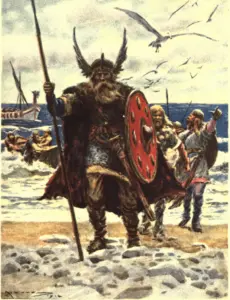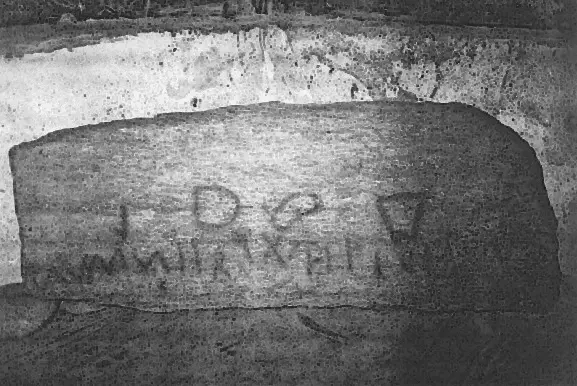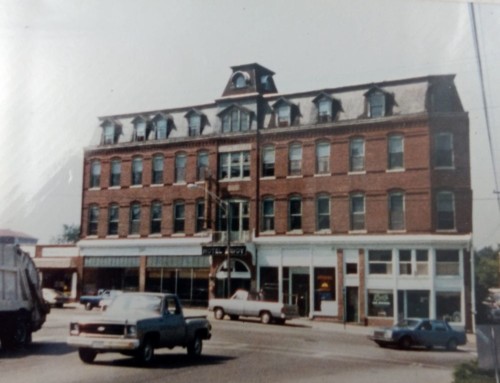About 500 years before Christopher Columbus is credited with discovering America Norsemen, whom we know today as Vikings, landed in North America. Some historians think they could have traveled through Rhode Island and even possibly sailed up Little Narragansett Bay to Westerly. One of those historians was the Reverend Canon W. David Crockett.
The Reverend Canon W. David Crockett was a distinguished scholar and theologian born in Charlestown and raised in Westerly. He was a graduate of Emerson College, Tufts University, and the Episcopal Theology School. During World War II he joined the Air Force and retired a lieutenant colonel in 1963. He taught public school in Westerly, at Emerson College and at the University of Massachusetts. He was ordained a priest in 1956 and among many other accomplishments was an associate at Christ Church in Westerly.
He wrote of the Viking trail in his book Archaeological Anomalies. “They had one settlement that we know of in Newfoundland, Canada at L’Anse Aux Meadows. The site was discovered at L’Anse aux Meadows in the 1960s and is the only confirmed Viking site in North America outside of the settlements found in Greenland. The Norse settlement at L’Anse aux Meadows has been dated to approximately 1,000 years ago.
The scarcity of artifacts found in Newfoundland and their nonexistence elsewhere on our coast is probably indicative of Viking frugality and haste in leaving this continent after less than cordial encounters with Native American Indians. Unlike Christopher Columbus’ settlement in Santo Domingo, there was no permanent occupation by the Norse in North America. However, Rune Stones found in Nova Scotia, Massachusetts, Connecticut, and Rhode Island give ample evidence of Viking explorations.”
Not all historians are in agreement about the extent of Viking exploration in the New World but some, like Crockett, think it was extensive. “In 1812 a marked rock was found on the shore of the Bay of Fundy opposite Yarmouth, Nova Scotia. This would have been on the sea route that the Vikings would have taken south,” Crockett writes. And in fact this rock covered in Norse runes is preserved in the Yarmouth County Museum and has several translations, one of which reads, “Leif Eiricson raises this monument.” Leif Eiricson was the son of Eiric the Red who’d led Norse settlers to Greenland.

Narragansett Rune Stone
If we follow the Viking trail south along the New England coast other evidence comes to light. At the Aptuexet Trading Post in Bourne, Massachusetts there is a 300-pound hunk of granite inscribed with runes. The runic inscriptions on the rock are undoubtedly Norse in origin.
According to Bourne Historical Society records, the stone likely was a doorstep for a Native American meetinghouse around 1680. The stone has been displayed at the Bourne Historical Center since 2003. Judy McAlister, director of the Jonathan Bourne Historical Center said, “Every expert who looks at it knows what it is, but they can’t agree.”
In 1952 another clue was found at Follins Pond which is up the Bass River on Cape Cod. This was the remains of ship-shoring, similar to shoring used by the Norse to careen and repair their ships.
Crockett wrote about what became known as the Narragansett Rune Stone. “In 1991, off North Kingstown, in the bay near a stream just south of Goddard Park there is a two-ton humped rock, another Rune Stone. The earliest known eyewitness accounts of the inscriptions on this rock were in 1948 from children who called it Indian Rock. The rock is covered by water at high tide and the runes can only be read during the low tide cycle. In 1984 a clam digger working from his skiff noticed the carved runes on its surface. He notified some experts in Norse runes.”

Landing of the Vikings
“One translation read, ‘Four victorious near the river,’ who these four Vikings were we will never know, but they probably got into a fight with Narragansett Indians near this spot. The Norse sagas are filled with descriptions of their conflicts with Native Americans.” In 2014 the Narragansett Rune Stone was moved and put on display in the village of Wickford where it can be seen today.
Reverend Canon Crockett spent a lot of time researching sites and wrote about a new one he had found. “I have recently learned about, but have yet to see, still another Norse Rune Stone. It was found in 1872 at Wequetequock at the site of the first English settlement in Stonington, Connecticut. I have no doubt that Vikings sailed into Little Narragansett Bay in their explorations of our coast.
The Viking Trail is definitely discernible along our coast. There can be no doubt about a Viking presence here a thousand years ago; and we’re fortunate in being able to witness the evidence of their presence right in our area.” Reverend Canon Crockett passed away in 2001, in Westerly, still believing the Vikings came here.
The controversy of whether Vikings were here a thousand years ago is still being contested by archeologists and historians today. Some think the Old Stone Tower in Newport and the many stone tunnels and other stone structures in our forests were left by the Vikings.
There are many other historical enigmas in New England like the Westford Knight in Westford, Massachusetts, the Dighton Rock in Berkley, Massachusetts, and the Newport Stone Tower in Rhode Island. Some of these enigmas have been at least partially explained by main stream historians, but what of the Rune Stones; these are much harder to explain. I like to think the Reverend Canon W. David Crockett had it right and that the Vikings did walk this land.






